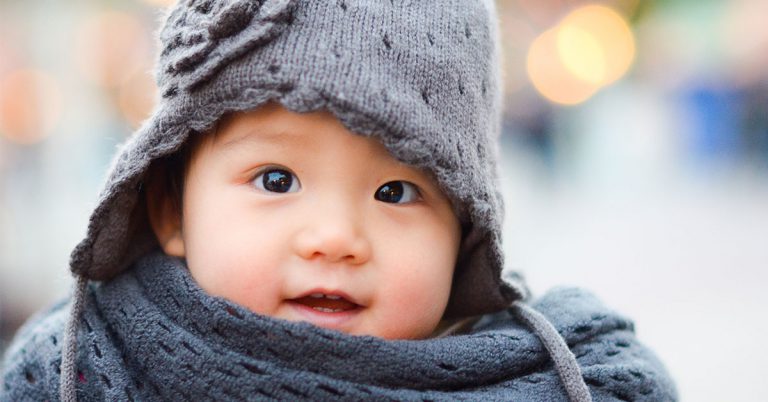
Baby, it’s not just cold outside, it’s freezing! And baby is entirely at your mercy to shield him from the elements. So snuggle up with this post, and learn how to keep your papoose protected.
- Love Those LayersThe best way to hang on to heat is by making sure it doesn’t escape in the first place. And lots of layers are the guardians at the gate of baby’s body temp. Start with a cotton snap-bottom undershirt, then add a fleece sleeper; next, button her into a bunting; and finally, wrap her in a blanket. Voilà! Cute, cozy, and completely covered to head out into the cold.Once you’re back inside, be mindful not to get distracted by pets, other kids, household tasks, etc. … Remove baby’s layers right away. A newborn is just as vulnerable (and helpless) when it comes to overheating.
- Transportation InsulationIf you have to transport baby on foot for any distance during the chilly winter months, place him in a front carrier inside your coat to help block wind and cold. … And make sure his mouth and nose aren’t obstructed.If you’re rolling by stroller, make sure all sides are secured with a blanket or some souped-up snow-and-wind-repellent accessory. And don’t forget the feet! Baby’s extremities, like all of baby, lose heat faster than adults, so be diligent about keeping tootsies toasty. … And, of course, mitten up, too.
- Hats Are TopsA warm hat — not just a cute hat — should be your No. 1 priority. On very cold days, be sure to use a cap that totally covers baby’s ears, fastens under the chin, is comfortable, not itchy, and one that won’t fall off.
- Harness Your Safety SensesThick coats should come off before the car-seat straps go on. The extra padding will make the straps too loose. Add a blanket or a bunting bag (usually a fitted fleece piece that attaches to a car seat) over the straps instead.To keep baby at a comfortable temperature, add or remove layers (i.e., the blankets and buntings mentioned above) as needed. If someone isn’t riding in back to assess that tiny temp from time to time, you can gauge it by your own. If you’re too hot or cold in the car, baby may be, too. Safely pulling over for a quick check is better than guessing or stressing.
- Heads-up on HypothermiaHypothermia develops when a child’s temperature falls below normal due to exposure to cold, and it can happen quickly with infants … even in a cold room. As hypothermia sets in, baby may shiver and become lethargic, or seem clumsy. If you suspect your infant is hypothermic, call 911 immediately. Until help arrives, take baby indoors, remove any wet clothing, and wrap her in blankets or warm clothes.
- Roadside RealitiesIf, for whatever reason, you get stuck on a winter road, you can stay safe inside your ride. Keeping an emergency roadside kit in your car is key, but baby may not directly benefit from its contents. To keep your little one (and you) cozy and calm, provide skin-to-skin contact as you nurse, bottle-feed, or just let your snuggle bug nap. Cover yourselves with extra blankets, nibble on snacks, and sip water until help arrives or you can move again.
- It’s Not Just Winter OutsideDrafts, cold spots, heating-bill-weary and carbon-footprint-conscious partners can sometimes make for a long, cold winter inside. But make sure it always feels sunny to your little honey.Keep their room at a temperate 72 degrees, give or take a couple ticks in either direction, depending on your home … and your baby.
Set infants up for sleep success by dressing them comfortably and baby-friendly. If you swaddle your child, use a lightweight cloth. Cotton is the best bet for sleeping, because it’s soft and more breathable than other fabrics. Skip blankets in the crib until around 12 months; they can be a suffocation risk, and babies typically kick them off anyway. Instead, try a sleep sack (a wearable blanket with armholes). A fitted flannel crib sheet adds warmth, too.Try a warm bath before bed. (Pediatricians recommend no more than three times per week during baby’s first year, for skin health.) And more skin-to-skin contact during a final feed, or just because it feels good before nodding off.
Get baby through their first winter like only you can. We hope our handful of hot tips helps.
References:
https://www.whattoexpect.com/baby-health-and-safety/dress-newborn.aspx
https://www.mother.ly/child/how-cold-is-too-cold-for-a-baby-to-go-outside